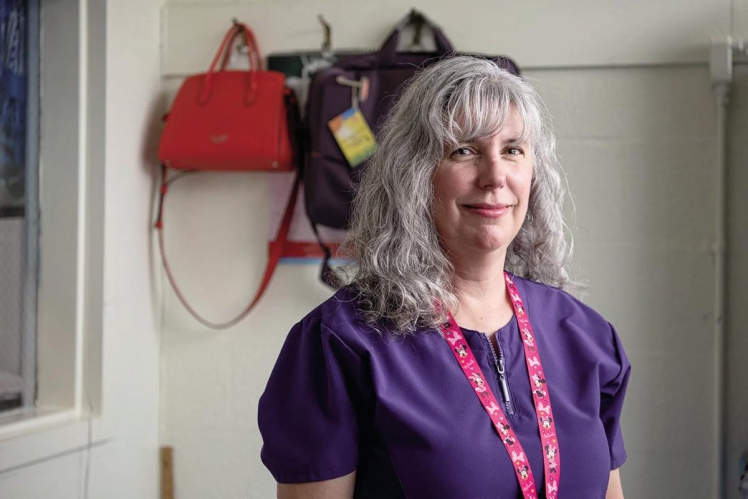WHAT'S HAPPENING
A THIRD OF SCHOOLS NATIONWIDE DON'T HAVE A NURSE. HERE'S WHY THAT'S A PROBLEM.
BY COLLEEN DEGUZMAN
Jodi Bobbitt, the school nurse at William Ramsay Elementary in Alexandria, Virginia, is always ready to see children with a wide range of injuries and illnesses. One day during the first week of school, the parade started before the first bell when a little girl walked in with red, irritated eyes.

STRETCHED THIN: Jodi Bobbitt is the only school nurse at William Ramsay Elementary in Alexandria, Virginia. In a previous school nursing job, she split her time between two school buildings — some years three. Now she has only one campus to care for.
Then it got busy. A student fell from the monkey bars and another tripped while playing tag. Two kids hit each other's heads with lunchboxes and needed ice packs. A young boy had a stomachache. Bobbitt also saw her regular kiddos: one who has special needs and uses a wheelchair and another who has diabetes and gets his blood sugar checked daily before lunch.
"Every day, I'm seeing more and more [youngsters]," Bobbitt, who is a certified nurse practitioner, said with a smile. "I saw more today than yesterday, so we just have to wait and see what the year has in store."
As the only school nurse at this suburban Washington, D.C., elementary school, Bobbitt's responsibilities extend beyond treating scraped knees and sniffles for the school's 600 pupils. At her under-the-seathemed clinic, she administers medications, teaches kids about health care, and conducts routine health screenings. As the school nurse, she also serves as a public health point person – tracking student vaccinations, linking parents to local health care resources, and communicating sometimes difficult messages to them, such as warnings about sexually transmitted diseases and signs of depression.
It's a full plate, but Bobbitt considers herself lucky. In a previous school nursing job, she split her time between two buildings within the same school district – some years three. What hasn't changed is that
school nurses play a critical role in keeping students healthy and ready to learn, but it's an often-unrecognized field for which schools struggle to attract and retain employees.
More than a third of schools nationwide don't have a full-time nurse on-site, according to a 2021 survey by the National Association of School Nurses. The schools that don't have a dedicated nurse either share one with other campuses, or don't have one at all. Meanwhile, the nation is facing high rates of chronic illnesses among K-12 students, such as diabetes and asthma, along with an unprecedented mental health crisis among youth, and school nurses are at the front lines — often, alone.
School nurses' roles were further complicated by covid-19. Since the pandemic took hold, they've been tasked with tracking cases and tracing exposures. An "extreme load of work was put on school nurses' shoulders during the pandemic," said Kate King, president of the NASN.
They got caught in the middle between anti-maskers and maskers and anti-vaccine and pro-vaccine parents, and were the
point of contact whenever students had to quarantine. "School nurses are used to interacting with parents who are angry," said King, but because of the pandemic "that anger just got to levels we had never seen before."
In general, kids' attendance and learning can suffer when students don't have access to a school nurse. "You're going to see more absences," she said, citing a study from the Journal of School Nursing that found students with illnesses or injuries were sent home 18% of the time when evaluated by an unlicensed school employee while only 5% went home after being seen by a school nurse.
Teachers and administrators are shouldering some of the burden by learning how to handle injuries and illnesses themselves, but "it doesn't take the place of having a school nurse who can respond immediately," King said.
Though there is no federal law requiring schools to have nurses on staff, the Centers for Disease Control and Prevention recommends at least one full-time nurse for every 750 students enrolled — but most